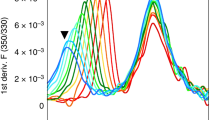Abstract
T CELLS recognize foreign protein antigens in the form of peptide fragments bound tightly to the outer aspect of molecules encoded by the major histocompatibility complex (MHC). Most of the amino-acid differences that distinguish MHC allelic variants line the peptide-binding cleft, and different allelic forms of MHC molecules bind distinct peptides1,2. It has been demonstrated that peptide-binding to MHC class I involves anchor residues in certain positions and that antigenic peptides associated with MHC class I exhibit allele-specific structural motifs3. We have previously reported an analysis of MHC class II-associated peptide sequences4. Here we extend this analysis and show that certain amino-acid residues occur at particular positions in the sequence of peptides binding to a given MHC class II molecule. These sequence motifs require the amino terminus to be shifted one or two positions to obtain alignment; such shifts occur naturally for a single peptide sequence without qualitatively altering CD4 T-cell recognition.
Similar content being viewed by others
References
Bjorkman, P. J. et al. Nature 329, 506–512 (1987).
Rothbard, J. B. & Getfer, M. L. A. Rev. Immun. 9, 527–565 (1991).
Falk, K., Rötzschke, O., Stevanovic, S., Jung, G. & Rammensee, H.-G. Nature 351, 290–296 (1991).
Rudensky, A. Y., Preston-Hurlburt, P., Hong, S.-C., Barlow, A. & Janeway, C. A. Jr Nature 353, 622–627 (1991).
Kappler, J., White, J., Wegmenn, D., Mustain, E. & Marrack, P. Proc. natn. Acad Sci. U.S.A. 79, 3604–3607 (1982).
Weiss, S. & Bogen, B. Proc. natn. Acad. Sci. U.S.A. 86, 282–286 (1989).
Rudensky, A. Yu. & Yurin, V. L. Eur. J. Immun. 19, 1677–1684 (1989).
Yurin, V. L., Rudensky, A. Y., Mazel, S. M. & Blechman, G. M. Eur. J. Immun. 19, 1685–1691 (1989).
Kabat, E. A., Wu, T. T., Perry, H. M., Gottesman, K. S. & Foeller, C. Sequences of Proteins of Immunological Interest 5th edn (US Department of Health and Human Services, NIH Publication No. 91-3242, 1991).
Rudensky, A. Yu., Rath, S., Preston-Hurlburt, P., Murphy, D. & Janeway, C. A. Jr Nature 353, 660–662 (1991).
Margulies, D. H. Curr. Biol. 2, 211–213 (1992).
Van Bleek, G. M. & Nathanson, S. G. Nature 348, 213–216 (1990).
Rötzschke, O. et al. Nature 348, 253–255 (1990).
Shumacher, T. N. M. et al. Nature 350, 703–706 (1991).
Hunt, D. F. et al. Science 256, 1817–1820 (1992).
Heber-Katz, E., Hansburg, D. & Schwartz, R. H. J. molec. cell. Immun. 1, 3–14 (1983).
Jardetzky, T. et al. EMBO J. 9, 1797–1803 (1990).
O'Sullivan, D. et al. J. Immun. 147, 2663–2669 (1991).
Murray, J. S., Pfeiffer, C., Madri, J. & Bottomly, K. Eur. J. Immun. 22, 559–565 (1992).
Sakai, K. et al. J. Neuroimmun. 19, 21–32 (1988).
Tuohy, V. K., Lu, Z., Sobel, R. A., Laursen, R. A. & Lees, M. B. J. Immun. 142, 1523–1527 (1989).
Chen, J. S., Lorenz, R. G., Goldberg, J. & Allen, P. M. J. Immun. 147, 3672–3678 (1991).
Shastri, N., Gammon, G., Miller, A. & Sercarz, E. E. J. exp. Med 164, 882–896 (1986).
Finnegan, A. et al. J. exp. Med 164, 897–910 (1986).
Jardetsky, T. et al. Nature 353, 326–330 (1991).
Rath, S., Lin, R.-H., Rudensky, A. & Janeway, C. A. Jr Eur. J. Immun. (in the press).
Pearson, W. R. & Lipman, D. J. Proc. natn. Acad. Sci. U.S.A. 85, 2444–2448 (1988).
Fremont, D. H., Matsumura, M., Stura, E. A., Peterson, P. A. & Wilson, I. A. Science 257, 919–927 (1992).
Matsumura, M., Fremont, D. H., Peterson, P. & Wilson, I. A. Science 257, 927–934 (1992).
Author information
Authors and Affiliations
Rights and permissions
About this article
Cite this article
Rudensky, A., Preston-Hurlburt,, P., Al-Ramadi, B. et al. Truncation variants of peptides isolated from MHC class II molecules suggest sequence motifs. Nature 359, 429–431 (1992). https://doi.org/10.1038/359429a0
Received:
Accepted:
Issue Date:
DOI: https://doi.org/10.1038/359429a0
- Springer Nature Limited
This article is cited by
-
A temporal thymic selection switch and ligand binding kinetics constrain neonatal Foxp3+ Treg cell development
Nature Immunology (2019)
-
The mechanisms of action of vaccines containing aluminum adjuvants: an in vitro vs in vivo paradigm
SpringerPlus (2015)
-
Integrating peptides' sequence and energy of contact residues information improves prediction of peptide and HLA-I binding with unknown alleles
BMC Bioinformatics (2013)
-
Manipulating Antigenic Ligand Strength to Selectively Target Myelin-Reactive CD4+ T Cells in EAE
Journal of Neuroimmune Pharmacology (2010)
-
Anatomy of CD1–lipid antigen complexes
Nature Reviews Immunology (2005)





